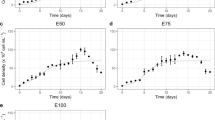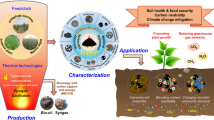Abstract
Temperature is an important factor affecting the water purification performance of constructed wetland (CW). In the previous study, the combined measures of Iris sibirica and aeration at the bottom of the first quarter filtration chamber could improve the pollutant removal capacity of CW at low temperature. However, the mechanism between the combined measures of Iris sibirica and aeration on enhancing the performance of domestic sewage treatment is unclear. Our study aims to provide scientific validation for the combined measure through monitoring the concentrations of dissolved oxygen (DO), chemical oxygen demand (CODCr), ammonia nitrogen (NH4+-N), and total nitrogen (TN) along the water flow pathway of the CW and measuring the superoxide dismutase (SOD) activities of the plants and the abundance of nitrogen cycle-related microbial functional genes in the substrates of CW to explore the mechanism of combined measures promoting the removal efficiency of the CW under low-temperature stress. Results showed that aerating at the bottom of the first quarter filtration chamber increased DO concentration in the front part of the CW, which benefited the aerobic removal of pollutants and the activities of microorganisms, and the removal CODCr and NH4+-N occurred mainly in the front part of the CW. SOD activities showed that I. sibirica had better resistance to low temperature than Canna indica did. The combined measures of I. sibirica and aeration activated the activities of microorganisms, increased the abundance of the denitrification process genes along the water flow pathway and formed a clear nitrification–denitrification zone in the CW, thus promoted the nitrogen removal efficiency at low temperature. Therefore, this study confirmed the feasibility of the combined measures from a mechanistic perspective.









Similar content being viewed by others
Data Availability
The data that support the findings of this study are available from the corresponding author, Shuiping Cheng, upon reasonable request.
References
Chen XY, Wu J, Chen Y et al (2022a) Research progress on water purification technology of low-temperature constructed wetland. Technol of Water Treat 48(01):7–12
Chen XY, Zhong F, Chen Y et al (2022b) The interaction effects of aeration and plant on the purification performance of horizontal subsurface flow constructed wetland. Int J Environ Res Public Health 19(3):1583
Fang J, Dong J, Li C et al (2021) Response of microbial community composition and function to emergent plant rhizosphere of a constructed wetland in northern China. Appl Soil Ecol 168:104141
Hu Y, He F, Ma L et al (2016) Microbial nitrogen removal pathways in integrated vertical-flow constructed wetland systems. Biores Technol 207:339–345
Kivaisi AK (2001) The potential for constructed wetlands for wastewater treatment and reuse in developing countries: a review. Ecol Eng 16(4):545–560
Li FM, Lu L, Zheng X et al (2014) Three-stage horizontal subsurface flow constructed wetlands for organics and nitrogen removal: effect of aeration. Ecol Eng 68:90–96
Li X, Li Y, Li Y et al (2019) Enhanced nitrogen removal and quantitative analysis of removal mechanism in multistage surface flow constructed wetlands for the large-scale treatment of swine wastewater. J Environ Manage 246:575–582
Li J, Zheng L et al (2021) Evaluation of an intermittent-aeration constructed wetland for removing residual organics and nutrients from secondary effluent: Performance and microbial analysis. Biores Technol 329:124897
Liao XK, Yan HL, Wang ZY et al (2020) Advance treatment of tail water using pilot-scale horizontal and vertical subsurface flow constructed wetlands in low-temperature seasons. Environ Sci 41(12):5509–5517
Liu SY, Yan BX, Wang LX (2010) Effect of different factors on nitrogen removal rate in constructed wetlands. Wetland Science 8(2):157–163
Liu F, Fan J, Du J et al (2019) Intensified nitrogen transformation in intermittently aerated constructed wetlands: Removal pathways and microbial response mechanism. Sci Total Environ 650:2880–2887
López-Gutiérrez JC, Henry S, Hallet S et al (2004) Quantification of an novel group of nitrate-reducing bacteria in the environment by real time PCR. J Microbiol Methods 57(3):399–407
Luan YP, Song LG, Lin JS et al (2022) Effect of various aeration parameters on stratificated nitrogen removal in the intermittent aeration vertical flow constructed wetland. Chinese J Environ Eng 16(01):164–172
Mei X, Xing D, Yang Y et al (2017) Adaptation of microbial community of the anode biofilm in microbial fuel cells to temperature. Bioelectrochemistry 117:29–33
Montecchio D, Mattei MR, Esposito G et al (2022) Mathematical modelling of an intermittent anoxic/aerobic MBBR: estimation of nitrification rates and energy savings. J Environ Manage 321:116026
Nanjing Jiancheng Bioengineering Research Institute. (2016) Instruction of malondialdehyde (MDA) test box: TBA method (EB/OL) 2016–06–16.
Pan FX, Lai XS, Wang SZ et al (2021) Influence of C/N ratio on the nitrogen removal and functional microbial abundance under aeration condition in horizontal subsurface flow constructed wetlands. Chinese J Environ Eng 15(04):1386–1394
Sims A, Gajaraj S, Hu Z (2012) Seasonal population changes of ammonia oxidizing organisms and their relationship to water quality in a constructed wetland. Ecol Eng 40:100–107
Song XQ (2007) Isolation and purification of SOD from maize. Dissertation, Hebei Agricultural University.
State environmental protection administration of China (2002) Analysis method of water and wastewater. Chinese Environmental Science Press, Beijing, China
Szukics U, Hackl E, Zechmeister-Boltenstern S et al (2012) Rapid and dissimilar response of ammonia oxidizing archaea and bacteria to nitrogen and water amendment in two temperate forest soils. Microbiol Res 167:103–109
Wang HL, He HP, Gong LZ et al (2011) Research progress on cold resistance of plant. Hubei Agric Sci 50(06):1091–1094+1100
Wang XO, Tian YM, Zhao XH et al (2015a) Effects of aeration position on organics, nitrogen and phosphorus removal in combined oxidation pond-constructed wetland systems. Biores Technol 198:7–15
Wang H, Ji G, Bai X et al (2015b) Assessing nitrogen transformation processes in a trickling filter under hydraulic loading rate constraints using nitrogen functional gene abundances. Bioresourouse Technology 177:217–223
Wang Q, Hu YB, Xie HJ et al (2018) Constructed wetlands: a review on the role of radial oxygen loss in the rhizosphere by macrophytes. Water 10(6):678
Wang X, Yang R, Guo Y et al (2019) Investigation of COD and COD/N ratio for the dominance of anammox pathway for nitrogen removal via isotope labelling technique and the relevant bacteria. J Hazard Mater 336:606–614
Wang T. (2016) Specie screening/heterotrophic culture optimization of Chlorella protothecoides and research on mechanisms of lipid accumulation under salt stress. Dissertation, East China University of Science and Technology.
Wei J, Xu C, Li KX et al (2020) Progress on superoxide dismutase and plant stress resistance. Plant Physiol J 56(12):2571–2584
Xie J, Ma XH, Dai YR et al (2017) Effects of organic matters on the abundance of microorganisms in the urban wetland. Biotechnol Bull 33(10):217–224
Xu JT, Zhang J, Xie HJ et al (2010) Physiological responses of Phragmites australis to wastewater with different chemical oxygen demands. Ecol Eng 36(10):1341–1347
Yao XH (2007) Effects of heavy metal cadmium pollution on physiological and biochemical characteristics of cucumber seedlings. J Henan Agric Sci 10:81–83
Ye X.C., & Guo X. (2011) Testing of winter vegetation construction and water purification effect of a cascaded wetland model of Jialu river. International Symposium on Water Resource and Environmental Protection 5893093.
Yi JT, Dong Y (2014) Analysis of influencing factors on biological nitrogen removal. Chem Manag 05:125
Zhang M, Tao R, Yang Y et al (2015) Effect of environmental factors on abundance of denitrifying genes in different types of constructed wetlands. Chinese J Environ Eng 9(06):2645–2652
Zhang LH (2014) The response of Iris siberian to cold and application. Xinyang Normal University.
Zhong F, Wu J, Dai YR et al (2015) Performance evaluation of wastewater treatment using horizontal subsurface flow constructed wetlands optimized by micro-aeration and substrate selection. Water Sci Technol 71(9):1317–1324
Zhu SS (2015) Research on influence of plant species richness on function of constructed wetland in the different seasons. Dissertation Harbin Industrial University.
Funding
This work was supported by (CSCEC-2021-Z-3) and (52170168). Author Shuiping Cheng has received research support from the China State Construction Engineering Corporation Science and Technology project and the National Natural Science Foundation of China.
Author information
Authors and Affiliations
Contributions
Conceptualization: Xinyi Chen, Shuiping Cheng; methodology: Xinyi Chen; formal analysis and investigation: Xinyi Chen, Juan Wu, Fei Zhong, Shuiping Cheng; writing — original draft preparation: Xinyi Chen, Fei Zhong, Shaole Yu, Kejian Chen, Xiangqian Zeng, Dongling Duan; writing — review and editing: Juan Wu, Shuiping Cheng; funding acquisition: Juan Wu, Shuiping Cheng; project administration: Shuiping Cheng; supervision: Shuiping Cheng; validation: Xinyi Chen, Fei Zhong, Shaole Yu; data curation: Juan Wu; software: Xinyi Chen, Kejian Chen, Xiangqian Zeng, Dongling Duan.
Corresponding author
Ethics declarations
Ethics approval
Not applicable.
Consent to participate
The authors have approved the manuscript and agreed with its submission to Environmental Science and Pollution Research.
Consent for publication
The authors have agreed to publish on Environmental Science and Pollution Research.
Competing interests
The authors declare no competing interests.
Additional information
Responsible Editor: Alexandros Stefanakis
Publisher's Note
Springer Nature remains neutral with regard to jurisdictional claims in published maps and institutional affiliations.
Rights and permissions
Springer Nature or its licensor (e.g. a society or other partner) holds exclusive rights to this article under a publishing agreement with the author(s) or other rightsholder(s); author self-archiving of the accepted manuscript version of this article is solely governed by the terms of such publishing agreement and applicable law.
About this article
Cite this article
Chen, X., Wu, J., Zhong, F. et al. Mechanism of Iris sibirica and aeration combination on promoting the water purification performance of constructed wetland under low temperature. Environ Sci Pollut Res 31, 19715–19724 (2024). https://doi.org/10.1007/s11356-024-32381-3
Received:
Accepted:
Published:
Issue Date:
DOI: https://doi.org/10.1007/s11356-024-32381-3




